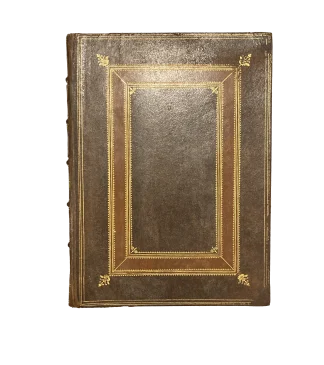NORDEN, John
WITH THE MAPS
Speculum Britanniae. The firste parte [...] [with] Speculum Britaniae, Pars the description of Hartfordshire […]
(1) London, [Eliot’s Court Press], 1593. (2) [London, Thomas Dawson], 1598.£9,000.00
(1) FIRST EDITION. 4to. Pp. [8] 48 [4]. Roman letter, a little italic. Three strengthened double fold out copper plate maps of Middlesex, London and Westminster by Peter van den Keere (1571-c.1646), in strong impression, full-page arms of Elizabeth I to verso of dedication. Engraved t-p with classical architectural setting flanked by two men in three quarter profile and contemporary dress, weapons or tools suspended above. Detailed index at end, final leaf with verses and errata.
(2) FIRST EDITION. 4to. Pp [8] 31 [1]. Roman letter, a little italic, mainly English text, some Latin. Title within geometric baroque frame with floral detail and a trefoil scene of a stag standing in a river. Foldout map of Hertfordshire by William Kip (active 1588-1635) in good impression, plate of arms of Elizabeth I. Historiated initials and ornaments to reader’s note and beginning of text. Dedication to Edward Seamor, reader’s note, and corrections preceding text. Final leaf strengthened, pages a little soiled.
Armorial bookplate of Richard Croft and paper label of Eric Sexton (1902-1980) to front pastedown, of Nathan of Churt (1889-1963) and leather label of Eric Sexton to ffep. Good, well-margined copies, some age yellowing and marginal foxing, in later speckled calf, tan panel central to cover, gilt ruled with floreate corner pieces. Small repair to lower outer corner of upper cover, rebacked, gilt dentelles, a.e.g.
A charming pair of works by renowned Elizabethan cartographer John Norden, surveying the history, political and geographical organisation, and general features of the counties of Middlesex, where Norden had his permanent home, and Hertfordshire. ‘His other surveys, which included Essex, Northampton, Cornwall, Kent and Surrey, were published at various later dates […] Norden’s intention was to compose a series of county histories, but lack of money intervened to prevent the completion of this design’. These were the only two published in his lifetime.
The first text lists the Saxon Alphabet before briefly laying out the (mostly Saxon) history of the county. The author lists and describes small scale geographical areas, such as hundreds, parks, roads, hills and market towns, as well local battles, ending with an alphabetical survey of settlements and houses of repute within the county, including coats of arms. He delves into the chronology of certain important sites, referring to a variety of sources such as Camden and Thomas Walsingham.
The maps are early examples of Flemish engraver and globe-maker Pieter can den Keere’s work, whose map of Ireland served as a model for later editions of Ortelius’ Theatrum. He also produced a series of 44 plates of the British Isles, based on the works of Saxton, Ortelius and Boazio, which began to appear from 1599. The map of Middlesex includes certain natural geographical features such as hills and forests, and the city of London is represented by a cluster of buildings, with London bridge visible crossing the river Thames. The city is shown is more detail in the second map complete with labels corresponding to letters on the map, which is surrounded by the arms of various guilds.
The second work on Hertfordshire is dedicated to Edward Seymour, 1st Earl of Hertford. It opens with a historical description of the county, along with a list of fairs, market-towns, and more general small-scale divisions, before presenting the alphabetical list of towns and settlements. After each entry is a letter and a number, which refers to a square on the gridded map, enabling the reader to locate each place. It ends with an alphabetical table of Houses and ‘’Beryes’’, an old English suffix denoting a town, which are organised in the same fashion. It features William Kip’s earliest published map, who later went on to have his work published in Camden’s atlas, Britannia. His style closely follows that of renowned cartographer Christopher Saxton (c.1540-1610), retaining much of the same detail.
This copy belonged to Harry Nathan, 1st Baron Nathan, originally a liberal politician, and later Labour, serving as a government minister under Clement Attlee.
ESTC: S113233, S113233; Lowndes: 1697-1698; Cox (Vol. III): 1593; not in Shirley or Burden.In stock







